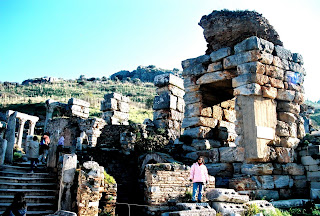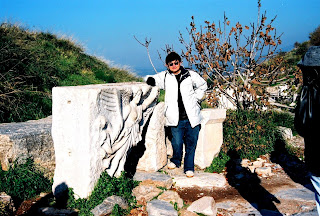
The city of Ephesus, well known as an outdoor museum of Turkey, is one of the most interesting and extensive ancient sites in the world and is the center of attraction in Aegean region of Turkey. It is located in Selcuk, 30 km away from a small port and resort town of Kusadai. Ephesus was excavated by British archaeologists during the last years of Ottoman Empire. The city was first established by Lonians in the 9th century BC. after Persian invasion (in 6th century). It was later under the control of Alexander the Great and his general Lysimachus. After Pergamum Kingdom, the city was ruled by Roman empire and many emperors of that period adorned the city with exquisite works of art and architecture. It was said that St Paul came to Ephesus city many times to spread Christianity when at that time it was only a new born religion. And Apostle John settled here until he died to write his book of Bible. Mother Mary after Jesus was crucified also followed Apostle and spend the last days of her life here.
Ephesus in fact witnessed the rise of Christianity.
Ephesus is the largest and most outstanding archeological site still existing in the world. Antique Theater of Ephesus (picture below) was able to hold 24k audiences for a concert at that time. Temple of Hadrian (top picture) displays a great architectural style of 2nd century. The reliefs and decoration on the facade of this 2nd century Corinthian temple are unique while the inner wall of the porch depicts the legendary founder of the city, Androklos and his works.




Ephesus city was once a trade center of the ancient world and religious center of the early Christianity and played a great role in ancient time. Picture shows a Roman Architectural Theater and the building of an ancient market built in 2000 yrs ago


The Odeon was the assembly hall for administrators of the city. It was also used for concerts. The top seat were destroyed but marble seat and entrance area are still intact. Ruins of the halls where official or judges used to meet.



The Scolastika Bath dated as the 1st century BC was completely renovated in the 4th century. The complex of this typical Roman bath consists of 4 sections: (1) a cold water pool (Frididarium) (2) a lukewarm bathing room (Tepidarium) (3) a steam room (Caldarium) and a Apoditerium .


(1) A lady's left foot, a woman and heart on marble ground, advertising woman's service in the early century, was the first signboard in the world (2) The well preserved public latrines were built in 9th century.


Several artifacts and attractive mosaic panels were unearthed during the excavations that carried out in the past decades. The architectural style of these houses clearly reflecting the social structure of that period.



Monumental gate of Agora lies next to the Library of Celsus.



Ephesus Library of Celsus is a piece of exquisite works of art and architecture. The huge marble bearing with hieroglyphic inscription stands next to the library.


Ephesus Library of Celsus is one of the leading restoration projects in the world. The outstanding structure, built in the 2nd century by a Roman consul in the memory of his father, was perfectly reconstructed as almost all pieces were found in the excavations. After reading the history written on the Memory board at the marble wall of Celsus Library, I sat at the main marble door of Celsus Library admiring the incredible work inherited down from the ancient time.



Goddess of Nike believed to offer people prosperity and wealth was along the Ephesus Curetes Street which was constructed with marble and was one of the leading restoration projects in the world. The priests called Curetes believed to have come from the island of Crete, used to walk down this trail to carry wood for the sacred fire and people who saw them would step aside.



Some ruins of Magnesia gate at the foot of Ephesus and nearby the local farmers raising sheep for wool and meat.


Home of Virgin Mary is the first church dedicated to Virgin Mary. The little chapel was believed to be where Virgin Mary lived and died. I could sense a strong energy that gave me peace in mind, while standing in front of Virgin Mary's status inside the chapel. Hanging against the wall outside the chapel were all kinds of wishes and it was said that couples never failed to have their dream come true if they were asking for baby.



(2) The little cosy post office and a village cottage house where you can see two glass bottles were placed at the top of the roof. This is an open way to announce that the family had two daughters ready for marry.


Huge status of The Ataturk in costume of whirling dervishes along the highway to Kusadasi, which is a beautiful bay harbor catering for tourist arriving by land or cruise ship to visit Ephesus. Kusadasi, parallel to the glorious ancient city in history and its nearby settlements has become the most popular tourist center in its nation.


No comments:
Post a Comment